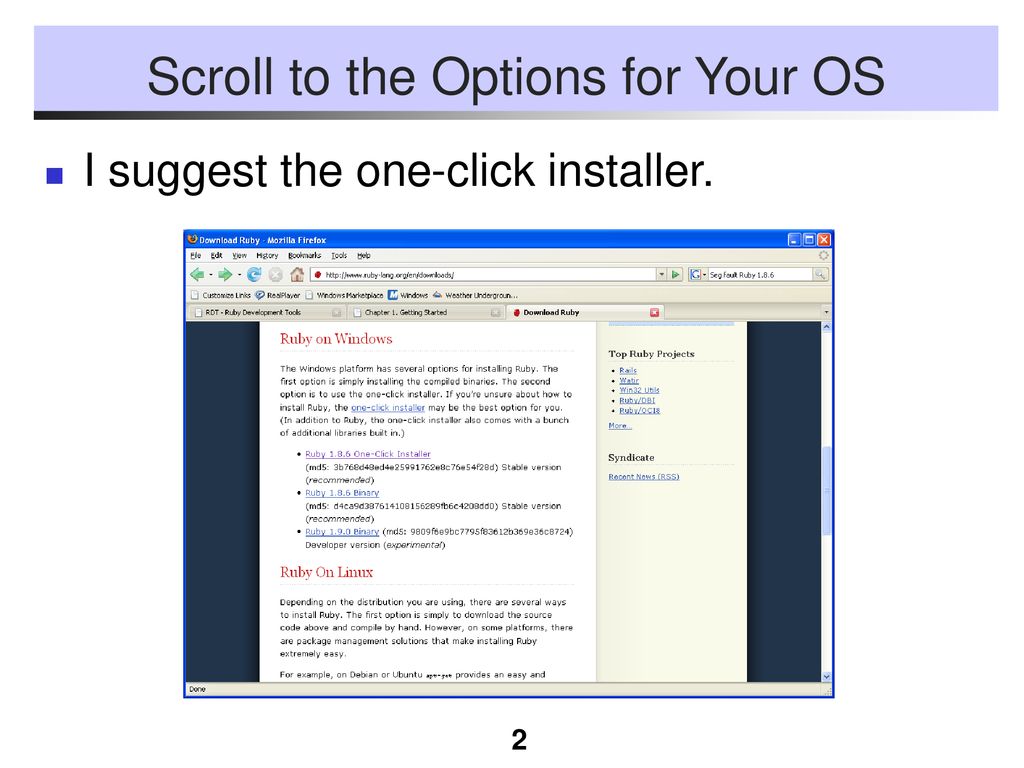

- Ruby download mac how to#
- Ruby download mac install#
- Ruby download mac update#
- Ruby download mac software#
- Ruby download mac code#
Just be patient until it completely loads and available. It may take some time to load for the first time. Once the installation is complete, open the BlueStacks software.Installation is as simple and easy as any other software installation.
Ruby download mac install#
Ruby download mac how to#
Enjoy Rubyįor developers planning to build web applications with Rails, I've written a guide, Install Rails on a Mac, which goes beyond Install Ruby on a Mac to show how to pick a version manager that will work with Node as well as Ruby.Įnjoy the pleasure of coding in Ruby! After all, it is known as a language dedicated to programmer happiness. If not, prepare yourself by installing Ruby with Homebrew or a version manager. If you're reading this at the end of 2021, the system Ruby may already be gone. Future versions of macOS won’t include scripting language runtimes by default, and might require you to install additional packages." Apple says: "Scripting language runtimes such as Python, Ruby, and Perl are included in macOS for compatibility with legacy software. MacOS Big Sur is now the current version.

When you start building another project, it may be time to install a version manager so you can juggle projects with different Ruby versions. If you're just starting with Ruby, install with Homebrew and work on a project with Ruby 3.0. The system Ruby in macOS Catalina or Big Sur is Ruby 2.6.3, which is old. When you start a project, use the newest Ruby release (it's 3.0 at the time this was written).

But it's easier to install Ruby with Homebrew or use a version manager and use the Bundler that comes installed, which will correctly set up your local development environment. You can work around the systems permission problem by installing Bundler with a command that uses your home directory for gems. If you were to use sudo to install gems with the system Ruby, you'd end up with a mess of incompatible gems in the system Ruby directory. Or maybe two different gems in your project rely on different versions of a dependent gem.īundler uses a Gemfile in your project directory to keep track of the gems you need. Imagine you've got projects that use different versions of a gem (maybe there was a new gem release between your projects). Gem managementĮxperienced developers use Bundler to install gems and manage their dependencies.
Ruby download mac code#
Even worse, a gem might contain malicious code that tampers with your computer. Don't do it! You may leave the system in a broken or compromised state. In this case, you need sudo because you're altering system files that are managed by the OS. But don't do this! $ sudo gem install railsĪny time you are about to run sudo, you should stop and ask if you're about to shoot yourself in the foot. You can install gems as a superuser to override the permissions restriction. Unix-based systems are powerful, so there's a workaround. You don't have write permissions for the /Library/Ruby/Gems/2.6.0 directory If you try to install a gem, for example gem install rails, you'll get a permissions error: ERROR: While executing gem. Ordinary users are not allowed to write to it (and you really shouldn't alter this folder). That directory is owned by root, the system superuser. If you use the Mac system Ruby, running gem install will try to save gems to the system Ruby directory /Library/Ruby/Gems/2.6.0. Most Ruby projects use at least a few gems.
Ruby download mac software#
RubyGems are the ready-made software libraries that make development easy and fun in Ruby. For a guide that compares version managers and shows the best way to install Ruby, see my article Install Ruby on a Mac.īut why not use the macOS default Ruby? Let's take a look at the reasons why it's a bad idea to use the Mac default Ruby for development.
Ruby download mac update#
Ruby for developmentįor developing projects with Ruby, you should Install Ruby with Homebrew or use a version manager such as asdf, chruby, rbenv, or rvm.Ī version manager helps if you're juggling multiple projects and can't update all at once. It's fine to use the system Ruby for running sysadmin scripts, as long as you don't alter the system Ruby by attempting to update it or add gems.īut you don't want to use it when you are developing projects in Ruby. If you see /usr/bin/ruby, it is the pre-installed macOS system Ruby. Use the which command to see where Ruby is installed: $ which ruby MacOS comes with a "system Ruby" pre-installed. Someone may have once told you, "Don't use the system Ruby." It's good advice, but why? Let's find out.


 0 kommentar(er)
0 kommentar(er)
